This weekend our family took the first of our annual trips up to our local farms. It's peach season and we are already a week behind! If you grew up in a family like mine then you had a home canned fruit or vegetable at your table a minimum of once a week. We enjoyed the "fruits" of my mothers labor. Although I do remember my sister saying a time or two how much she HATES snapping beans. Ah, lovely memories. We began our canning season this year with green beans grown from our garden. Passed down from my mother, we only grow Royal Burgandy Beans. They are a beautiful purple on the vine. There are a few things I like about purple beans among which is the fact that they are much easier to see when you are picking them. They always taste great and we have never had any lack of growth from them. Last year we canned regular green beans picked from a farm and they are unfortunately still sitting on the shelf in the basement. The taste and texture just doesn't compare to the purple beans. Okay on the the reason for this post. It's not like I've been called a Chatty Kathy before or anything. Next we canned our peaches. This is the only thing we ran out of since canning last year so we'll have to be sure to make more this season. A few tools that you will need when you start canning: Jars (quart or pint to suit your preference, also make sure there are no nicks on the top or it won't seal) Lids and Rings (widemouth or regular to match your jars) A nice sharp paring knife Magnetic Lid Lifter (this tool will save your fingers from those unwelcome burns) Jar Lifter Canning Books (unless you have a fountain of information just a phone call away, i.e. my mom) Steam Canner or Water Bath Canner A Helper (if you are lucky enough to find one)
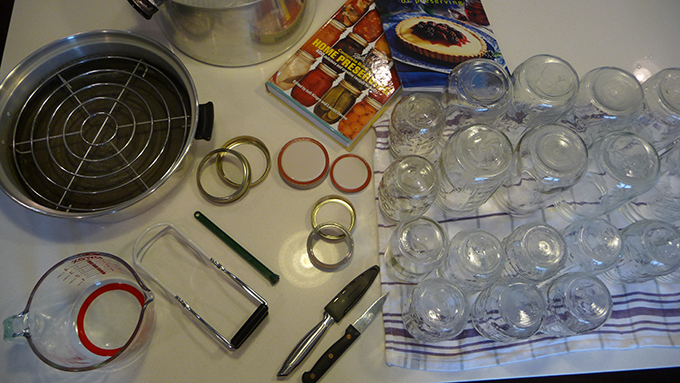
If you are doing a lot of peaches it's beneficial to have several LARGE pots so you can do more at one time. Alright here's where you start. Are you ready? Go pick your peaches! The most important part! Duh! This year we picked a type of peach we have never canned before. They are called a Flamin' Fury. I hope they taste as good as they sound! Other peaches that are good for canning would be Red Haven, GloHaven, Red Globe, or Elberta. There are lots of others that you can can as well. You should be able to find the best for your area by asking some local growers. When picking your peaches you want to make sure that they are just at the right spot for canning. If you pick your peaches green then the skins WILL NOT come off and you will be cursing up and down at your kitchen sink. You want your peach to be slightly soft to the touch. You don't want it to mush in your hand, but you don't want it to feel like a rock either. It needs to have a little give to it. Ripe peaches bruise very easily so they need to be canned the day of picking or at the very least the next day, otherwise they will be a mushy icky mess, bleh! As you can see in the picture below we waited until the next day to can our peaches and they are already beginning to bruise.
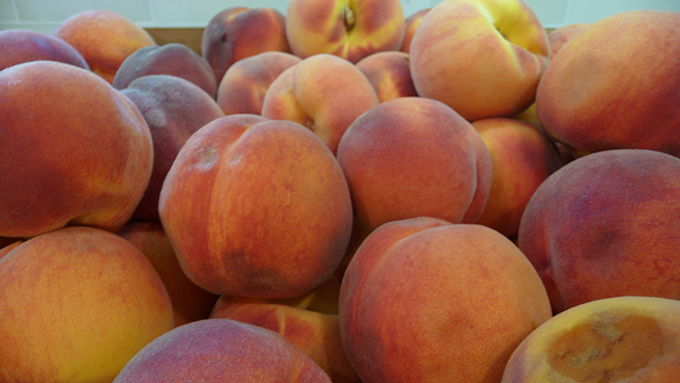
When you are ready to can you'll want to get your boiling liquids going first. On the back burner we use a large pot where we have plain boiling water to put our peaches in. On the left is our simple syrup and on the right is our small pot for boiling our lids. The simple syrup you use is completely up to you. We use a light syrup so our ratio is 4 quarts water to 2 cups sugar. You can use a heavier simple syrup which just means using more sugar in your water. When your sugar water is boiling it is ready. You'll want to keep it hot all the way through the canning process. If you start running out just add more water and sugar and bring it to a boil again.
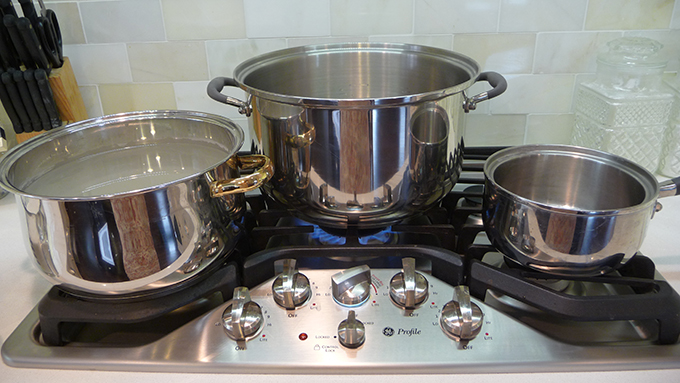
Next is to throw (or toss gently if you don't want to splash boiling water everywhere) your peaches into the boiling water. You want them to be completely submerged. Let them sit for 30-60 seconds. Take one out and put it into your cold water and see how easily the skin comes off. If it slips off easily then they are ready. If you find yourself trying to peel the skin off then let them sit in the boiling water a little longer.
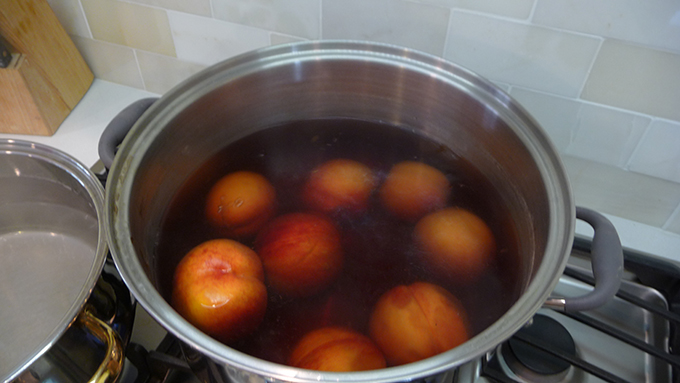
When you remove your peaches from the pot they go directly into the cold water and here is where the fun starts! Slip the skin off! I would do this one at a time as you are filling a jar. Once you have the skin off, cut the peach to your preference. We have always sectioned our peaches into about sixths but many people like to just half the peach. If you half your peaches you want to lay them all facing the same way in your jar to maximize your space. If you are going to section your peaches just start filling your jar at random. If you get a peach with a "split pit" be sure none of the pit is left on the flesh. When you feel like your jar is getting full lay a towel down on the counter and gently tap the jar down to give you more space at the top. Not tapping your jars results in wasted jar space. The one on the right is my husbands, lol. In all truthfulness, I think he likes canning more than I do. He was a trooper and did the peaches all by himself last year.
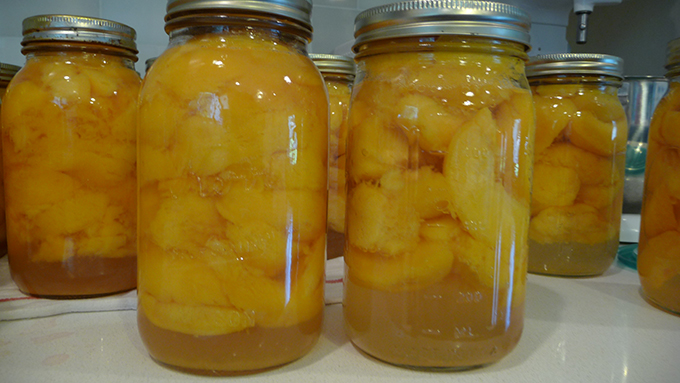
When your jar is full, wipe the top off with a wet towel to make sure it is clear of sticky liquid. Some people at this point will treat the peaches to keep them from browning but if you are filling them with your syrup fast then they won't turn brown. I have never treated my peaches and have never had a problem. It's up to you. Fill your jar with your sugar water. I just use a large glass measurer with a pour spout to scoop my syrup and pour into my jars. Try to get as many air bubbles out as you can. If it helps you can slide a knife or other skinny tool down the side to try to wiggle some of them out. Take your handy dandy magnetic lid lifter and grab a lid out of the boiling water (see how this saves your fingers from getting burned). Put your ring on and set to the side. Now do this about 100 more times, ha ha ha ha ha. Well, at least until your peaches are all in the jars. You are now ready to vacuum seal your jars. You can do this either with a water bath or with a steam canner. I prefer steam canning as it uses less water so it's faster to boil and I think it's easier to get the jars in and out of the pot. Fill your canner. Our canner will fit seven quarts.
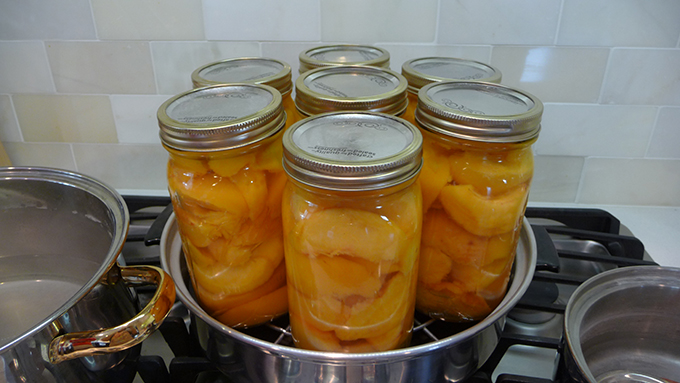
When you are all filled up you'll want to steam or bath them based on the manufacturers specifications. For our specific canner we heat the water and when we see steam pouring from the little hole on the side we start the timer. Quarts get steamed for 25 minutes and pints for 20.
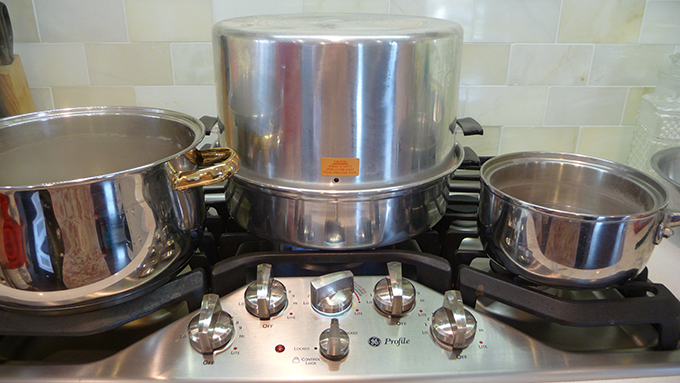
Once the timer goes off you remove the top of your canner. Be VERY CAREFUL when taking the lid off, it will be very hot! Open the top away from your face. Take your jar lifter and remove the jars to a towel. While cooling, the jars will all seal (well if you have done it correctly, other wise you'll be eating a lot of peaches really fast, lol). To know if they have sealed, the tops of the jars will be popped in. If they are not sealed you will be able to push the top down and it will pop back out and make a clicking noise. You are ALMOST DONE! Before putting your jars away you'll want to wipe them down to make sure they are very clean and stick free, then label the year on the lid. And that's it! Your done! Hallelujah! Now you get to enjoy the "fruits" of your own labor! If you are particular about knowing what you are eating, then canning (especially if you have grown it yourself) is a great way to go. Not only is it healthy but it gives great personal satisfaction. It also tastes pretty darn great! When our canning season is over I love to go down to our food storage and look at all the beautiful jars full of our hard work.
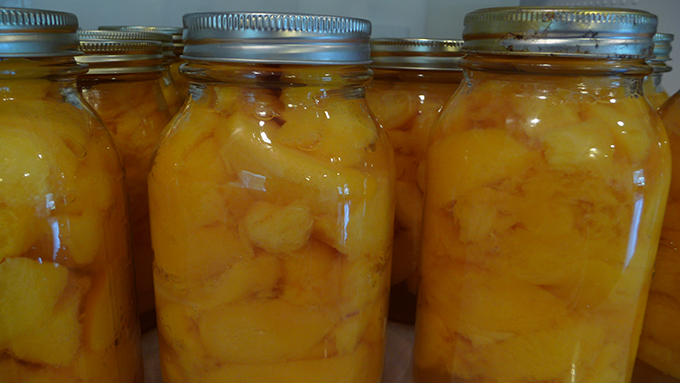
Next week we will be picking more peaches to make a few other things a little more interesting like freezer peach pie filling, peach jam, and pureed peaches (perfect baby food). My husband also likes to find new recipes to try so we'll see if his Peach Cobbler Spread turns out! GOOD LUCK! If you are looking for more information on canning you can visit nchfp.uga.edu. What else can you do with mason jars? Find out soon.
Tags
- Facebook Like
- Google Plus One

- Log in to post comments





